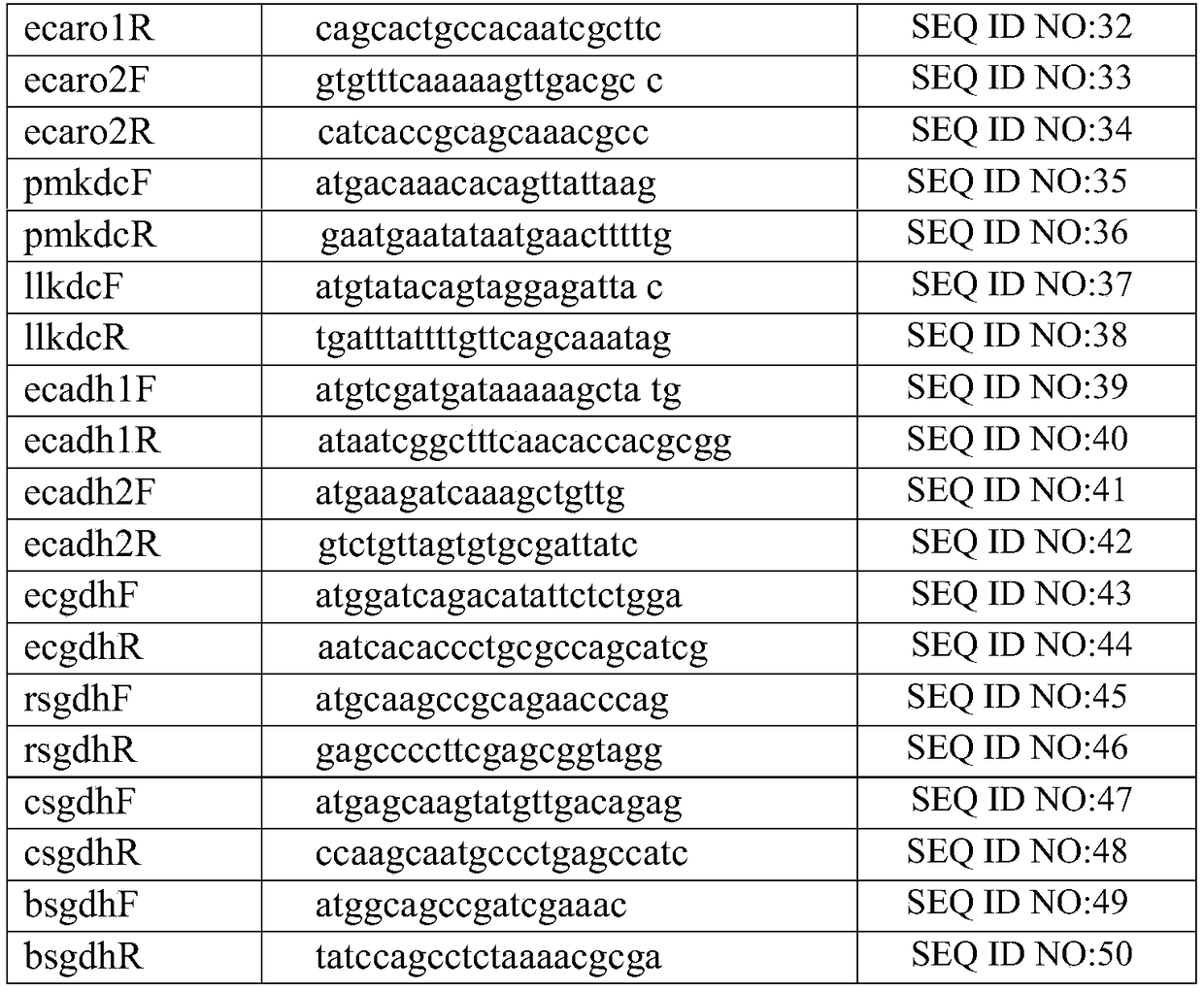Engineering bacterium and application thereof in tyrosol production
A technology of recombinant bacteria and Escherichia coli, which is applied in the field of bioengineering, can solve the problems of low yield of tyrosol produced by Escherichia coli, incompatibility of plant protein, and affecting the rate of aldehyde reduction, etc., achieving good industrial application prospects and strong optical specificity , the effect of improving production efficiency
- Summary
- Abstract
- Description
- Claims
- Application Information
AI Technical Summary
Problems solved by technology
Method used
Image
Examples
Embodiment 1
[0070] (1) Primer design
[0071] Design primers for PCR amplification.
[0072] (2) PCR amplification
[0073] According to the instruction manual of the Genomic DNA Purification Kit kit from Takara Company, the genomic DNA of wild strains in the logarithmic growth phase was extracted, and the primers in Table 1 were used to perform PCR amplification using the genome extracted from each corresponding strain as a template. The amplification system is: Prime STARHS DNA Polymerase (2.55U / μL) 0.5 μL, 10×PrimeSTAR Buffer 10 μL, dNTP Mixture (2.5mM each) 4 μL, template DNA 1 μL, Up primer (20 μM) 1 μL, Down primer (20 μM) 1 μL, wxya 2 O to make up to 50 μL. The amplification program is: 94°C, 10min; 94°C, 30sec; 55°C, 30sec; 72°C, 2min, a total of 30 cycles; 72°C, 10min. PCR products were sent to BGI for sequencing.
[0074] Later, L-α-amino acid transaminase genes lparo and lcaro were respectively cloned from Lactobacillus plantarum ATCC 14917 and Lacto...
Embodiment 2
[0083] For the screening of L-α-amino acid transaminase, a variety of recombinant engineering bacteria containing L-α-amino acid transaminase genes were obtained from Example 1, and expressed in Escherichia coli BL21 (DE3). Induced expression method: the recombinant Escherichia coli is transferred to LB fermentation medium (peptone 10g / L, yeast powder 5g / L, NaCl 10g / L) in the amount of 2% by volume ratio, when the cell OD 600 After reaching 0.6-0.8, add IPTG with a final concentration of 0.4mM, induce expression and culture at 20°C for 8h. After induction of expression, the cells were collected by centrifugation at 20° C., 8000 rpm, and 20 minutes. Collect the cells, break the cells to measure the activity of the crude enzyme solution, and compare the activities of various enzymes when α-ketoglutarate is used as the receptor. (11): 1346-1358.) The method measures the activity of L-α-amino acid transaminase, and the results are shown in Table 2. Therefore, it is best to choos...
Embodiment 3
[0087] The screening of L-glutamic acid dehydrogenase obtains the recombinant engineered bacterium of multiple gene containing L-glutamic acid dehydrogenase from embodiment 1, according to the induced expression method in embodiment 2, and in E.coli Expressed in BL21(DE3). According to the literature (cloning, expression and enzyme activity determination of Bacillus natto glutamic acid dehydrogenase gene. Shanghai Jiaotong University Journal of Agricultural Sciences, 2010, 1:82-86.), the activity of the crude enzyme solution was determined by breaking the cells. Determination of L-glutamate dehydrogenase and NAD + is the activity of the coenzyme, and the results are shown in Table 3. Therefore, it is best to choose L-glutamate dehydrogenase bsgdh derived from Bacillus subtilis for the production of tyrosol.
[0088] Table 3 Activity comparison of different L-glutamate dehydrogenases
[0089] Recombinant bacteria
PUM
 Login to View More
Login to View More Abstract
Description
Claims
Application Information
 Login to View More
Login to View More - R&D
- Intellectual Property
- Life Sciences
- Materials
- Tech Scout
- Unparalleled Data Quality
- Higher Quality Content
- 60% Fewer Hallucinations
Browse by: Latest US Patents, China's latest patents, Technical Efficacy Thesaurus, Application Domain, Technology Topic, Popular Technical Reports.
© 2025 PatSnap. All rights reserved.Legal|Privacy policy|Modern Slavery Act Transparency Statement|Sitemap|About US| Contact US: help@patsnap.com



